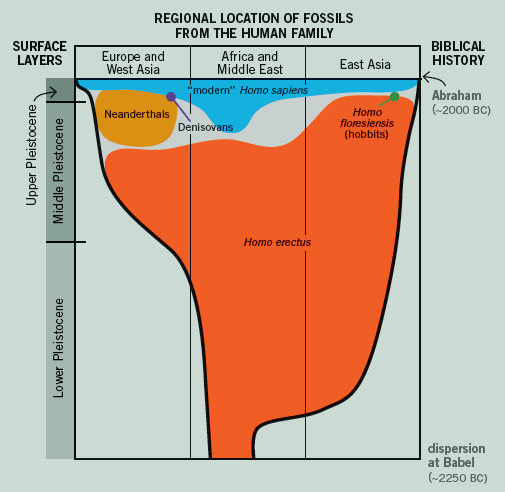
Promethean Hypothesis from Cooking Fire
Promethean hypothesis picks up steam from residual cooking fire.
News Source
- Boston University: “Playing with Fire”
South African archaeological spelunking has confirmed “cavemen” knew how to keep the home-fires burning. High-tech “microstratigraphic” analysis of sediment excavated 30 meters inside the cave entrance provided “unambiguous evidence in the form of burned bone and ashed plant remains that burning events took place in Wonderwerk Cave during the early Acheulean [Homo erectus] occupation, approximately 1.0 Ma,”1 write the investigators in Proceedings of the National Academy of Sciences.
“We collect an intact block of material, something the size of a milk container where everything is preserved in its original shape,” says co-author Paul Goldberg. “We can pick out a block of this stuff . . . dry it, soak it in polyester or epoxy resin and turn it into a rock, essentially. Once we do that, we can slice it just like geologists do, mount it on a slide and then look at it under the microscope.”
This archaeological confirmation of an ancient cooking fire comes on the heels of a recent study asserting the small teeth of Homo erectus were “adapted to a diet of cooked food”2 and supporting—according to evolutionists—primatologist Richard Wrangham’s “cooking hypothesis.” The title of Wrangham’s book, Catching Fire: How Cooking Made Us Human, sums up his contention that learning to control fire and cook food was the secret to humanity’s evolutionary success. (See “Cooking: The World’s Oldest Profession” for a discussion of these culinary ramifications.)
“It [cooking food] gave extra energy, used for evolutionary success; reduced feeding time, freeing men to hunt; lowered weaning time, creating bigger families; allowed brain size to increase; gave us our shortfaced, flat-bellied anatomy; enabled the sexual division of labour,” says Wrangham. “It was so important that it likely drove the evolution of our genus Homo. Basically, if the cooking hypothesis is right it turned us from advanced ape to early human.”
The researchers, like Wrangham, believe “the ability to control fire was a crucial turning point in human evolution”3 and that the ability to cook had to be in the hominin skill set by 1.9 million years ago, the time evolutionists claim Homo erectus evolved. These findings are the “earliest” known evidence of controlled use of fire and therefore are assumed to support these Promethean concepts of human evolution. (For readers rusty on their classical mythology, Prometheus was the Greek Titan credited in Greek mythology and the plays of Aeschylus and Shelley with giving mankind the gift of fire.)
The researchers have ruled out wildfire, convinced the fire was a controlled fire fed by plant material and that debris was not washed or blown in. Goldberg believes “it was unlikely there was any vegetation of wood or wood-like material that would have been there [30 meters inside] to burn on the spot – you can exclude local burning of material by natural causes. These ashes are really quite delicate, so they can't have been transported by wind or water, they would have never survived as intact pieces. It [the fire] has to be something local, right there on the spot.”
They also found “pot-lid flakes [of iron] (some refittable to the original slabs)”4 of ironstone rock above the cave. Humans must have brought these pieces of iron into the cave, according to Goldberg.5 The fractures found in these iron artifacts can be duplicated by experimentally heating iron to over 500 degrees Celsius, again suggesting that iron and fire were used by the occupants, possibly for cooking.
The million-year date ascribed to the burned debris was obtained by integrating paleomagnetic data and cosmogenic isotopic (26Al/10Be) ratios measured outside the cave in recent years.6 The latter measurements are based on decay of beryllium-10 and aluminum-26 isotopes formed in sand exposed to cosmic radiation. Magnetic field reversals are thought to affect the rate of isotope formation, allowing magnetic and isotope data to be integrated. (Decreased magnetic field intensity during reversal would allow more cosmic rays to reach earth causing an increase in isotope production.)
Paleomagnetic reversals are conventionally thought to indicate long ages based on the assumed long age of the earth. Creationist physicist Dr. Russ Humphreys has proposed, however, that convection currents in the core of the earth—affected by Flood-associated tectonic shifts—reversed earth’s magnetic field every few weeks during the global Flood.7 Subsequent research has documented analogous rapid magnetic field reversals in thin layers of cooled lava.8 Thus paleomagnetic dating is unreliable because magnetic reversals can occur rapidly and likely did so during the global Flood.
Furthermore, many factors can affect the geochemical cycling of these isotopes, including altered production rate due to magnetic reversals and other causes, changes in atmospheric circulation of the isotopes, and changes in precipitation.9 Thus these dating methods, singly and together, suffer from the usual problems with unverifiable assumptions that haunt other radiometric dating methods. In particular, the global Flood very likely affected the calibration of at least one of the parameters in a dramatic way for which observable geology has provided an analogous model. Without the million-year date, these findings become merely confirmation that early humans knew how to cook.
Homo erectus was fully human and, like Neanderthals and early modern humans, had smaller teeth than apes’ teeth.
Homo erectus was fully human and, like Neanderthals and early modern humans, had smaller teeth than apes’ teeth. Intelligent descendants of people scattered from the tower of Babel, they would all know how to cook. There is no proof cooking enabled “hominins” to evolve bigger, better brains. Brain size is not linked to human intelligence, so the fact that Homo erectus had cranial capacity on the small end of human average and Neanderthals had cranial capacity on the large end fails to show an ascending human evolutionary path. Nothing in the study supports the concept of human evolution from brutish or ape-like ancestors.
On the other hand, the historical accounts in the Bible shed light on the post-Flood Ice Age and the dispersion of Noah’s descendants from Babel, showing how human fossils like Homo erectus fit the biblical picture. Homo erectus, Neanderthals, and Denisovans appear in the Pleistocene rock layers as do extinct Ice Age animals. While Genesis does not offer the details of the post-Flood climate change, the natural result of the global Flood was the Ice Age that affected so much of our world for hundreds of years. People migrating from Babel had to cope with those climate changes and probably used caves for shelter and to bury their dead.
Homo erectus fossils, with “large brow ridges, small chins, and receding foreheads”10 along with their characteristic tools are preserved near Babel in the Lower and Middle Pleistocene layers of East Africa and Central Asia. Homo erectus fossils also appear farther from Babel in Upper Pleistocene layers along with other varieties of people, such as Neanderthals and the very short Homo floresiensis of Indonesia. Yet the fossil record does not preserve further record of these members of the human race after the Ice Age, suggesting they ultimately succumbed. Without DNA from Homo erectus we cannot document whether they live on in modern humans as do Neanderthals, but there is no reason to doubt their humanity or their intelligence—or to suppose they were evolving quasi-humans whose humanity depended on newly acquired culinary skills.
Further Reading
- Axing Evolutionary ideas—Stone Dead!
- Still Trying to Make Ice Cores Old
- The “Principle of Least Astonishment”!
- Were Cavemen Real?
- When Did Cavemen Live?
- Neanderthals vs. Humans: Are They Different?
For More Information: Get Answers
Remember, if you see a news story that might merit some attention, let us know about it! (Note: if the story originates from the Associated Press, FOX News, MSNBC, the New York Times, or another major national media outlet, we will most likely have already heard about it.) And thanks to all of our readers who have submitted great news tips to us. If you didn’t catch all the latest News to Know, why not take a look to see what you’ve missed?
(Please note that links will take you directly to the source. Answers in Genesis is not responsible for content on the websites to which we refer. For more information, please see our Privacy Policy.)
Footnotes
- Francesco Berna et al., “Microstratigraphic Evidence of in Situ Fire in the Acheulean Strata of Wonderwerk Cave, Northern Cape Province, South Africa,” PNAS, April 2, 2012, http://www.pnas.org/content/early/2012/03/27/1117620109.full.pdf+html.
- Ibid.
- Ibid.
- Ibid. This clarification and reference were added April 20, 2012.
- Alok Jha, “Scientists Find Clue to Human Evolution’s Burning Question,” The Guardian, April 2, 2012, http://www.guardian.co.uk/science/2012/apr/02/scientists-clue-human-evolution-question.
- Berna et al., “Microstratigraphic Evidence of in Situ Fire in the Acheulean Strata of Wonderwerk Cave, Northern Cape Province, South Africa: Supporting Information,” http://www.pnas.org/content/suppl/2012/03/28/1117620109.DCSupplemental/pnas.201117620SI.pdf; and A. Matmon, et al., “Reconstructing the History of Sediment Deposition in Caves: A Case Study from Wonderwerk Cave, South Africa,” Geological Society of America Bulletin 124, no. 3–4 (October 14, 2011): 611–625, http://gsabulletin.gsapubs.org/content/124/3-4/611.
- D. R. Humphreys, “Reversals of the Earth’s Magnetic Field During the Genesis Flood,” in R. E. Walsh, C. L. Brooks, and R. S. Crowell (editors), Proceedings of the First International Conference on Creationism Volume II Technical Symposium Sessions and Additional Topics (Pittsburgh, Pennsylvania: Creation Science Fellowship, 1986), 113–126.
- Andrew A. Snelling, “The ‘Principle of Least Astonishment’!,” Journal of Creation 9, no. 2 (August 1, 1995): 138–139, https://answersingenesis.org/geology/the-principle-of-least-astonishment/; and Ronald T. Merrill, “Principle of Least Astonishment,” Nature 374 (April 20, 1994): 674–675, doi:10.1038/374674a0.
- See Michael J. Oard, “Still Trying to Make Ice Cores Old,” Answers in Genesis, December 28, 2006, https://answersingenesis.org/environmental-science/ice-age/still-trying-to-make-ice-cores-old/.
- Andrew A. Snelling and Mike Matthews, “When Did Cavemen Live?,” Answers 7, no. 2: 50–55, https://answersingenesis.org/human-evolution/cavemen/when-did-cavemen-live/.

Answers in Genesis is an apologetics ministry, dedicated to helping Christians defend their faith and proclaim the good news of Jesus Christ.
- Customer Service 800.778.3390
- Available Monday–Friday | 9 AM–5 PM ET
- © 2025 Answers in Genesis




